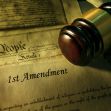On July 19, 2021, Attorney General Merrick B. Garland banned the use of warrants, subpoenas or court orders to seize reporters’ records from communications firms, publishers, or the reporters’ employers in attempts to discover confidential sources when leaks are being investigated. The prohibition applies to testimony, telephone records, metadata, documents, or digital content. This mandate creates clear new limits on what had become standard procedure.
In a three-page memo to federal prosecutors, Garland wrote “The Department of Justice will no longer use compulsory legal process for the purpose of obtaining information from or records of members of the news media acting within the scope of news-gathering activities.” Garland also noted that departmental regulations will be revised to include this new limit.
The memo also bans requiring reporters to turn over their notes or testify about their sources. Garland said the department will support legislation granting reporters’ information greater protections to ensure that his policy changes survive future administrations.
A set of exceptions was included in the memo. Exceptions would be made if:
• A reporter is under investigation for an unrelated crime
• The department is seeking to authenticate already published information
• A reporter is suspected of “breaking and entering” or a similar crime to gather information
• The reporter has been deemed a member of a foreign terrorist group or an agent of a foreign power
• Seizing the reporters' records is “necessary to prevent an imminent risk of death or serious bodily harm, including terrorist acts, kidnappings, specified offenses against a minor,” the memo said. It also included attacks on critical infrastructure.
The memo comes in response to President Biden’s vow last month not to allow seizures of reporters’ email and phone records after the department’s disclosures that these acts had taken place late in the Trump administration in cases dealing with CNN, the Washington Post, and the New York Times.
Court filings that were recently unsealed showed that on December 22, the day before William P. Barr left office as attorney general, the Justice Department tried secretly to get court orders to seize email records of reporters at The Times and The Post.
The reporters’ phone records were seized separately by prosecutors without court orders. The email data was never obtained, but the fight bled into the early Biden era. A highly unusual imposition of gag orders on lawyers and executives of The Times was the result. The subject of that investigation was leaks that took place in 2017.
The outcry over the revelations that those records were seized as part of the Trump administration’s investigations into who had spilled government secrets about the Russia investigation and some other national security issues was, in part, what prompted Garland to create the memo. Records in that investigation were also obtained from Democratic members of Congress, aides, and Don McGahn, former White House counsel.
A.G. Sulzberger, publisher of The Times, called for additional Congressional action but praised the memo, saying, “The new policy, which largely bars federal prosecutors from subpoenaing news media records or testimony, represents a significant step forward in the protection of press freedom. But there is still more to be done, and we urge the Biden administration to work with Congress to pass a federal shield law to make these improvements permanent.”
Bruce Brown, the executive director of the Reporters Committee for Freedom of the Press, said, “The attorney general has taken a necessary and momentous step to protect press freedom at a critical time. This historic new policy will ensure that journalists can do their job of informing the public without fear of federal government intrusion into their relationships with confidential sources.”
Before the changes, prosecutors were required to get permission to seize reporters’ data. They were supposed to notify the news organizations ahead of time so the breadth of the requests could be challenged in court or negotiated. A few high-level officials or the attorney general could make exceptions.
Current AG Garland met with newsroom leaders and seems to have agreed to end such seizures. Advocates of press freedoms praised his memo as a significant alteration in how the department has operated under all previous administrations.
Jameel Jaffer is the director of the Knight First Amendment Institute at Columbia University. He called the new policy “an important step forward.” He said, “This will help ensure that journalists can do the work we need them to do — shine a light on government conduct, inform public debate, and hold the powerful accountable — no matter which party is in control of the executive branch.”
Jaffer also pointed out gaps that remain in the new regulation, including how broadly the department would interpret some terms in the new rules, such as “news gathering.” He also noted that the memo discusses forbidding compulsory legal tools that were in the old regulation, such as subpoenas, warrants and court orders, but does not mention another tool the department has used: a national security letter.
The wording of Garland’s memo seems to indicate that a reporter’s records would still be protected in situations where the source is suspected of being an outside hacker who stole information, rather than a government insider who leaked it. The pertinent language says the prohibition would apply when “a member of the news media has, in the course of news gathering, only possessed or published government information, including classified information.”
The government could still seize records of officials suspected of being leaks. The new limits only apply to reporters’ records.
Previously, the Justice Department used a “balancing test” to determine when prosecutors could seize reporters’ records. Protecting a free flow of information to the press was balanced against the interest in collecting evidence that could solve crimes. Of that approach, Garland wrote in the memo, “Because a free and independent press is vital to the functioning of our democracy, the Department of Justice has long employed procedural protections and a balancing test to restrict the use of compulsory process to obtain information from or records of members of the media. There are, however, shortcomings to any balancing test in this context.” His new policy aims to help guard journalists’ ability to do their work.
Garland wrote, “The United States has, of course, an important national interest in protecting national security information against unauthorized disclosure. But a balancing test may fail to properly weight the important national interest in protecting journalists from compelled disclosure of information revealing their sources, sources they need to apprise the American people of the workings of their government.”






